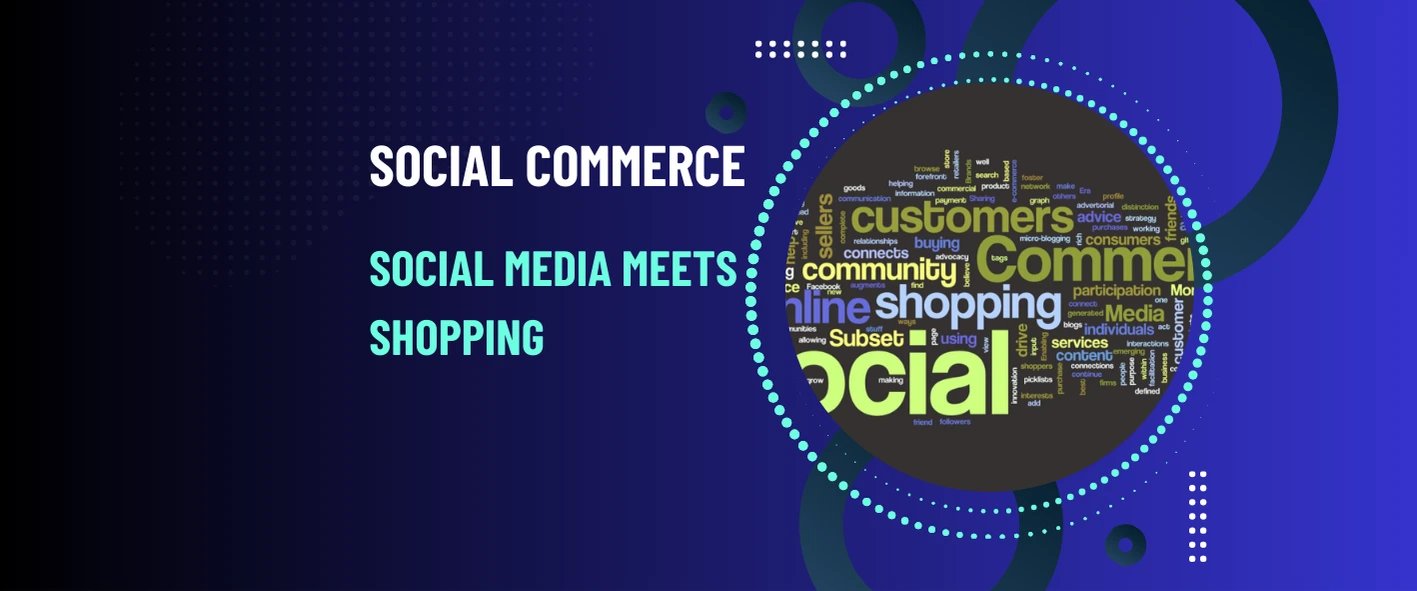Social Commerce: Transforming Social Media Platforms into Vibrant E-Commerce Hubs

Social media platforms have rapidly evolved into powerful e-commerce engines, reshaping the shopping landscape and redefining how consumers interact with brands. Social commerce, the integration of social media and online shopping, offers a seamless way for users to discover, engage with, and purchase products all within their favorite apps. With features like shoppable posts, live-stream shopping, and in-app checkouts, platforms such as TikTok, Instagram, and Facebook are revolutionizing the online shopping experience.
This article explores the rise of social commerce, examining how platforms are becoming e-commerce hubs, the shifting behaviors of modern consumers, and actionable strategies for brands to thrive in this dynamic space. Whether you’re a business owner, marketer, or shopper, this guide highlights the challenges, opportunities, and future of social commerce.
Table of Contents
Transforming the Way We Shop Online
Definition of Social Commerce
Social commerce refers to the seamless integration of social media platforms and e-commerce, allowing users to discover, evaluate, and purchase products directly within their favorite social apps. Unlike traditional e-commerce that redirects users to external websites, social commerce creates a unified experience where browsing, engagement, and transactions happen in one place. By leveraging features like shoppable posts, live-stream shopping events, and in-app checkout systems, social commerce bridges the gap between social interaction and online shopping.
Brief History and Evolution of Social Commerce
- The Beginnings of Social Commerce:
The concept of social commerce emerged in the mid-2000s, when platforms such as Facebook and MySpace introduced tools enabling businesses to showcase their products. While these efforts laid the groundwork, the shopping experience often required users to leave the platform, limiting the potential of social commerce. - The Transformation with Shoppable Features:
The late 2010s marked a turning point with the introduction of shoppable posts on Instagram and Pinterest’s “buy buttons.” These innovations allowed users to make purchases without navigating away from the platform, streamlining the customer journey and increasing conversion rates. - Today’s Social Commerce Ecosystem:
In the present day, platforms like TikTok, Instagram, and Facebook have transformed into dynamic e-commerce hubs. TikTok’s “Shoppertainment” model, which merges entertainment with shopping, has captured audiences worldwide. Live commerce, influencer partnerships, and AI-driven personalization further define the modern social commerce experience.
Importance of Social Commerce in Today’s Digital Economy
- Convenience and Accessibility:
Social commerce eliminates friction in the customer journey, making it easier than ever for consumers to discover and buy products within the same app. This convenience is particularly appealing to mobile-first shoppers who value a streamlined experience. - Community and Trust:
Peer recommendations, influencer endorsements, and user-generated content (UGC) are key drivers of trust in social commerce. These elements create an authentic shopping experience, encouraging consumers to engage and convert. - Economic Impact:
Social commerce is a growing contributor to the global digital economy, representing billions in annual sales. For small and medium-sized businesses, it provides a cost-effective entry point to compete with larger brands, democratizing access to e-commerce opportunities. - Emerging Technologies:
The integration of augmented reality (AR), artificial intelligence (AI), and machine learning has elevated the capabilities of social commerce. These technologies provide personalized product recommendations and immersive shopping experiences, setting the stage for continued growth.
Key Statistics Highlighting the Rise of Social Commerce
- Revenue Growth: Social commerce sales in the U.S. are forecasted to exceed $80 billion by 2025, making up more than 10% of total e-commerce revenue.
- Platform Influence: Reports show that 70% of shopping enthusiasts turn to Instagram for product discovery, while TikTok’s “Shoppertainment” approach has driven a 553% increase in global commerce interactions.
- Consumer Behavior: A survey by eMarketer indicates that 49% of consumers are influenced by social media recommendations when making purchase decisions.
- Engagement Metrics: Platforms like Facebook Marketplace and Instagram Shopping report significantly higher engagement rates compared to traditional e-commerce websites.
Social Media as E-Commerce Hubs

The Convergence of Social Media and Shopping
Social media platforms have evolved beyond spaces for communication and entertainment—they are now full-fledged e-commerce hubs. With features like in-app shopping, shoppable posts, and live-stream shopping events, social platforms seamlessly blend social interaction with transactional functionality. This convergence has transformed the customer journey into a streamlined process, reducing the friction typically associated with traditional e-commerce.
- Examples of Integration:
- Instagram: Shoppable posts and in-app checkout allow users to browse and buy products without leaving the app.
- TikTok: The rise of “Shoppertainment” merges viral content with commerce, offering a unique blend of engagement and shopping.
- Facebook: Marketplace and business pages provide diverse options for peer-to-peer and business-to-consumer transactions.
- Impact on Consumer Behavior:
This seamless integration makes shopping feel less like a chore and more like a natural part of the social media experience, leading to higher engagement and conversion rates.
Table 1. Comparison of Social Commerce Features Across Platforms
| Platform | Key Features | Target Audience | Unique Strengths |
|---|---|---|---|
| TikTok | Live shopping, “Shoppertainment” | Gen Z and Millennials | Viral content-driven shopping experiences |
| Shoppable posts, in-app checkout | Millennials and Gen Z | Visually rich product discovery | |
| Marketplace, business pages | All age groups | Community-driven and peer-to-peer commerce | |
| Buyable pins, visual search | Creative and DIY enthusiasts | Discovery-oriented, visual commerce | |
| Snapchat | AR shopping, shoppable ads | Gen Z | Augmented reality try-ons |
The Role of Algorithms and Personalization
Algorithms play a crucial role in shaping the success of social commerce. By analyzing user behavior, preferences, and interactions, social media platforms can curate highly personalized shopping experiences that drive conversions.
- Key Features Enabled by Algorithms:
- Product Recommendations: Based on browsing and engagement history, platforms suggest products that align with a user’s interests.
- Targeted Ads: Businesses leverage algorithmic insights to reach potential buyers with tailored advertisements.
- Influencer Content: Algorithms prioritize influencer posts that resonate with audiences, increasing product visibility.
- Case Studies:
- Instagram: Uses machine learning to highlight relevant products in Explore and Stories based on a user’s activity.
- TikTok: Employs the For You Page (FYP) to introduce users to products featured in viral content.
Key Metrics Driving Social Commerce Success
Social commerce is not just about integrating shopping features; it’s also about tracking and optimizing performance metrics that lead to better results for businesses.
- Metrics to Monitor:
- Engagement Rates: Interaction levels on shoppable posts, live videos, and influencer content.
- Conversion Rates: The percentage of users who make a purchase after engaging with a product.
- Average Order Value (AOV): How much a consumer spends per transaction in social commerce channels.
- Click-Through Rates (CTR): How often users click on product links or shoppable tags.
- Role of User-Generated Content (UGC):
UGC serves as a powerful driver for social commerce. Consumers trust content created by peers more than traditional advertisements, making UGC a cornerstone of successful social commerce campaigns.
Table 2. Metrics to Measure Social Commerce Success
| Metric | Definition | Why It Matters |
|---|---|---|
| Engagement Rate | Percentage of likes, shares, comments per post | Indicates content relevance and impact |
| Conversion Rate | Percentage of users who make a purchase | Measures the effectiveness of campaigns |
| Average Order Value (AOV) | Average amount spent per transaction | Tracks revenue generation per purchase |
| Click-Through Rate (CTR) | Percentage of users clicking on product links | Shows interest in shoppable content |
| Return on Investment (ROI) | Revenue generated versus campaign costs | Evaluates profitability of social campaigns |
Emerging Features Transforming Social Commerce
- Live Shopping:
Platforms like TikTok and Facebook are embracing live-stream shopping events, where influencers or brands showcase products in real-time. These events foster immediacy and interaction, driving impulse purchases. - Augmented Reality (AR):
AR features, such as Instagram’s try-on tools, allow consumers to visualize products in their space or on themselves before buying. This technology enhances confidence in purchase decisions. - Chat Commerce:
Integrated messaging tools, like WhatsApp for Business or Facebook Messenger, enable direct communication between brands and customers, simplifying inquiries and purchases.
Social media platforms have successfully positioned themselves as e-commerce hubs by combining engagement, personalization, and cutting-edge technology. With algorithms driving relevance and metrics ensuring optimization, social commerce provides both consumers and businesses with a dynamic, interactive marketplace. This transformation represents a significant shift in the e-commerce landscape, setting the stage for even greater innovations in the future.
Shifting Consumer Behavior

The Rise of In-App Purchases
Consumer shopping habits are evolving rapidly, with in-app purchases becoming the preferred method for many shoppers. Social media platforms now offer seamless purchase pathways that eliminate the need to leave the app, making the shopping experience fast, convenient, and enjoyable.
- Convenience as a Driving Force:
The simplicity of clicking on a product tag and completing a purchase within seconds has made in-app purchases a cornerstone of social commerce. Platforms like Instagram, TikTok, and Facebook have introduced native checkout options, allowing users to finalize transactions without interruptions. - Statistics on In-App Purchases:
- 62% of users are more likely to purchase a product if they can do so directly within the app.
- Platforms with streamlined in-app purchasing options see 30% higher conversion rates compared to those requiring external links.
- Examples of Success:
- TikTok: The TikTok Shop feature enables brands to leverage viral trends, driving impulse buys with ease.
- Facebook Marketplace: Combines social connectivity with in-app payment options to streamline the buying and selling process.
Table 3. Shifting Consumer Behavior Statistics
| Behavior | Statistic | Source |
|---|---|---|
| Preference for in-app purchases | 62% of users prefer in-app transactions | [Source: eMarketer] |
| Influence of social recommendations | 49% of consumers rely on peer reviews | [Source: Nielsen] |
| TikTok’s global commerce growth | 553% increase in commerce interactions | [Source: TikTok Insights] |
| Gen Z’s use of social platforms | 70% use Instagram for product discovery | [Source: Statista] |
The Influence of Social Proof
Social proof, the concept that people are influenced by the actions and opinions of others, plays a pivotal role in shaping consumer behavior on social commerce platforms.
- User-Generated Content (UGC):
UGC, such as reviews, testimonials, and real-life product images, helps establish trust. Platforms like Instagram and TikTok encourage users to share their experiences, which act as powerful endorsements. - Influencer Marketing:
Influencers bridge the gap between brands and consumers by providing authentic, relatable product recommendations.- Example: A beauty influencer showcasing a skincare product on Instagram Stories with a direct purchase link often generates higher engagement and sales than traditional advertising.
- The Power of Reviews:
Consumers often rely on peer reviews when making purchasing decisions. Platforms that integrate review sections directly into their shopping features, such as Facebook Marketplace, foster transparency and trust.
Demographic Insights
Different demographics approach social commerce in unique ways, shaped by preferences, expectations, and levels of digital fluency.
- Gen Z (Ages 18–24):
- Prefer platforms like TikTok and Snapchat for their engaging and interactive shopping experiences.
- Value authenticity and are highly influenced by viral trends and peer recommendations.
- Millennials (Ages 25–40):
- Gravitate toward Instagram for its visually appealing and curated shopping experiences.
- Look for convenience and personalized recommendations.
- Generation X and Boomers (Ages 41+):
- Favor Facebook for its familiar interface and community-driven shopping options.
- Tend to value detailed product descriptions and user reviews.
- Key Consumer Trends:
- A growing demand for live commerce experiences across age groups.
- Increasing preference for environmentally conscious and socially responsible brands.
Consumer Expectations from Social Commerce
Consumers have high expectations for their social commerce experiences, which brands must address to build loyalty and drive sales.
- Personalized Experiences:
Consumers expect product recommendations tailored to their preferences and behavior. Social platforms use AI-driven algorithms to fulfill these demands, offering curated shopping feeds and targeted ads. - Seamless Interactions:
Frictionless transactions, intuitive interfaces, and quick customer support are crucial for retaining shoppers. Platforms like WhatsApp for Business and Facebook Messenger enable real-time brand-to-consumer communication. - Visual Appeal and Storytelling:
Social media is inherently visual, and shoppers expect brands to leverage high-quality images, engaging videos, and compelling narratives. Platforms like Instagram thrive by combining these elements into their shopping experiences.
Shifting consumer behavior underscores the power of social commerce to redefine the shopping journey. From the rise of in-app purchases to the influence of social proof and demographic-specific preferences, understanding these trends allows brands to tailor their strategies effectively. By aligning with consumer expectations for convenience, personalization, and authenticity, businesses can unlock the full potential of social commerce and foster long-term customer loyalty.
Table 4. Benefits of Social Commerce for Businesses
| Benefit | Description | Example |
|---|---|---|
| Increased Accessibility | Low barriers for small businesses to enter | Small brands selling directly via Instagram |
| Enhanced Personalization | AI-driven recommendations tailored to users | TikTok’s For You Page suggesting products |
| Higher Engagement Rates | Interactive features increase user participation | Instagram Reels with shoppable links |
| Direct Customer Feedback | Instant feedback through comments and reviews | Facebook comments used to refine products |
Strategies for Brands to Leverage Social Commerce
Building a Strong Social Media Presence
A robust social media presence is the foundation for any successful social commerce strategy. By combining engaging content with shopping features, brands can attract, retain, and convert their target audiences.
- Consistent Branding Across Platforms:
- Ensure visual and tonal consistency across Instagram, TikTok, Facebook, and other platforms.
- Use cohesive color schemes, logos, and messaging to establish brand recognition.
- Engaging Content Creation:
- Leverage visually appealing content, including shoppable posts, stories, and videos.
- Highlight product benefits with real-life applications to connect with audiences.
- Use Instagram Reels and TikTok videos for interactive, entertaining product showcases.
- Interactive Features:
- Conduct polls, quizzes, and giveaways to engage followers and foster a sense of community.
- Use Instagram’s “Ask Me Anything” or Facebook Live Q&A sessions to directly address customer queries.
Collaborating with Influencers
Influencer marketing is one of the most effective tools in social commerce, helping brands build credibility and reach new audiences.
- Choosing the Right Influencers:
- Collaborate with influencers who align with your brand’s values and target audience.
- Micro-influencers (1,000–100,000 followers) often drive higher engagement in niche markets.
- Effective Campaign Strategies:
- Provide influencers with creative freedom to produce authentic content.
- Encourage influencers to use product links, shoppable tags, and discount codes to measure campaign success.
- Case Study:
- A beauty brand partnered with TikTok influencers for a product launch. Viral content generated a 40% increase in sales within a week.
Utilizing Data and Analytics
Harnessing data and analytics is crucial for optimizing social commerce strategies and maximizing ROI.
- Understanding Customer Behavior:
- Analyze social media insights to identify customer preferences, behaviors, and pain points.
- Monitor engagement metrics (likes, shares, comments) to evaluate content performance.
- Measuring Campaign Success:
- Use metrics such as click-through rates (CTR), conversion rates, and average order value (AOV) to assess performance.
- Leverage tools like Facebook Ads Manager and Instagram Insights for detailed analytics.
- Adapting Based on Insights:
- Refine strategies based on data trends, such as increasing investment in high-performing content types or focusing on top-performing platforms.
Embracing Interactive Features
Interactive features provide brands with a unique way to engage audiences and drive sales.
- Live Commerce:
- Host live shopping events on platforms like Instagram and TikTok to demonstrate products and answer questions in real time.
- Create urgency with limited-time offers or exclusive discounts during the event.
- AR and VR Tools:
- Use augmented reality (AR) tools for virtual try-ons (e.g., makeup, clothing).
- Implement virtual reality (VR) experiences to offer immersive product showcases, especially for luxury goods.
- Chat Commerce:
- Utilize chatbots or live messaging tools on platforms like WhatsApp and Messenger to provide instant support and personalized recommendations.
Fostering Community and Loyalty
Building an engaged and loyal community around your brand enhances trust and long-term customer retention.
- Encourage User-Generated Content (UGC):
- Motivate customers to share photos and reviews of your products on social media.
- Create branded hashtags to track and amplify UGC.
- Implement Loyalty Programs:
- Reward repeat customers with exclusive offers, discounts, or early access to new products.
- Integrate loyalty features directly into your social commerce platform (e.g., points for sharing or purchasing).
- Collaborate with Communities:
- Partner with community groups or influencers to promote your products in relevant niches.
- Use Facebook Groups or TikTok challenges to create buzz around your brand.
By adopting these strategies, brands can unlock the full potential of social commerce to drive engagement, conversions, and loyalty. A strong social media presence, strategic influencer partnerships, data-driven decision-making, and community-building initiatives are key to thriving in this dynamic landscape. Brands that prioritize interactivity, personalization, and authenticity will be best positioned to succeed in the ever-evolving world of social commerce.
Challenges and Opportunities

Navigating Privacy Concerns
As social commerce grows, so do concerns around data privacy. Consumers are increasingly wary of how their data is collected and used, while stricter regulations challenge brands to adapt.
- Impact of Data Privacy Regulations:
- Laws like the GDPR (General Data Protection Regulation) and CCPA (California Consumer Privacy Act) impose strict requirements on data collection, storage, and usage.
- Platforms must ensure transparency and compliance to maintain consumer trust.
- Balancing Personalization with Privacy:
- Personalization drives social commerce success, but achieving this while respecting user privacy can be challenging.
- Brands should adopt ethical data practices, such as obtaining explicit consent and allowing users to control their data preferences.
- Strategies to Overcome Privacy Concerns:
- Leverage first-party data collected directly from customer interactions (e.g., email sign-ups, purchase history).
- Use privacy-conscious tools and analytics that minimize data exposure.
Table 5. Challenges and Solutions in Social Commerce
| Challenge | Description | Proposed Solution |
|---|---|---|
| Privacy Concerns | User data misuse fears | Transparent data collection policies |
| Algorithm Dependence | Changes impact visibility | Diversify content and invest in paid ads |
| Market Saturation | High competition | Unique value propositions and niche focus |
| Platform-Specific Regulations | Varying policies across platforms | Stay updated on guidelines and adapt quickly |
Adapting to Rapid Changes
The dynamic nature of social media platforms poses challenges for brands trying to keep up with constantly evolving features, algorithms, and consumer trends.
- Algorithm Updates:
- Platforms frequently update algorithms that determine the visibility of content, impacting organic reach and engagement.
- Brands must diversify their content strategies and invest in paid ads to maintain visibility.
- Emerging Features and Platforms:
- New features, like TikTok’s live shopping events or Instagram’s augmented reality (AR) tools, require brands to continuously adapt.
- Staying ahead involves testing and adopting these features early to gain a competitive edge.
- Strategies to Stay Agile:
- Monitor industry news and platform updates regularly.
- Allocate budget and resources for experimentation with new tools and platforms.
- Foster a culture of innovation within the team to quickly adapt to changes.
Opportunities in Emerging Markets
Social commerce is expanding rapidly in emerging markets, presenting significant opportunities for growth.
- The Growth of Mobile Commerce in Developing Regions:
- Increased smartphone penetration and internet access in regions like Southeast Asia, Africa, and Latin America have accelerated social commerce adoption.
- Platforms like WhatsApp and Facebook dominate in these markets due to their accessibility and familiarity.
- Localized Strategies for Success:
- Tailor content and campaigns to the cultural preferences and languages of specific regions.
- Focus on affordable pricing and flexible payment options, such as cash-on-delivery or mobile wallets.
- Expanding Beyond Traditional Markets:
- Brands entering emerging markets early can build strong loyalty and establish themselves as leaders.
- Partnerships with local influencers and community groups can enhance credibility and reach.
Embracing Technological Advancements
Technologies like AI, AR, and VR offer innovative opportunities to enhance the social commerce experience.
- Artificial Intelligence (AI):
- AI-powered recommendation engines personalize product suggestions based on browsing and purchase history.
- Chatbots and virtual assistants provide instant customer support, improving satisfaction and conversions.
- Augmented Reality (AR) and Virtual Reality (VR):
- AR tools allow customers to visualize products in real-world contexts (e.g., furniture in their living room or makeup on their face).
- VR offers immersive shopping experiences, particularly for luxury goods or real estate.
- Blockchain and Payment Innovations:
- Blockchain technology ensures secure and transparent transactions.
- Cryptocurrencies and digital wallets expand payment options, particularly in regions with limited banking infrastructure.
Overcoming Competition and Saturation
With the rapid rise of social commerce, brands face increasing competition and market saturation.
- Standing Out in a Crowded Market:
- Unique value propositions (UVPs) are critical to differentiate from competitors.
- Creative content, storytelling, and authentic engagement help capture attention.
- Leveraging Niche Markets:
- Focus on niche audiences with tailored products and messaging.
- Small, underserved segments often offer higher engagement and loyalty potential.
- Building Long-Term Loyalty:
- Invest in customer retention strategies, such as loyalty programs and exclusive deals for repeat customers.
- Continuously innovate to meet evolving customer expectations.
Social commerce presents both challenges and opportunities in today’s dynamic landscape. Brands that address privacy concerns, adapt to rapid changes, explore emerging markets, and embrace new technologies will be better positioned to thrive. By overcoming competition and saturation with unique strategies, businesses can unlock the vast potential of social commerce, transforming challenges into growth opportunities.
Conclusion
Social commerce has emerged as a transformative force in the digital economy, blending the engaging nature of social media with the convenience of online shopping. Platforms like TikTok, Instagram, and Facebook have revolutionized the shopping journey, allowing users to discover, evaluate, and purchase products without ever leaving the app. This seamless integration has not only simplified the consumer experience but has also opened up vast opportunities for brands to connect with their audiences in innovative ways.
From the rise of in-app purchases to the influence of user-generated content and the power of live commerce, social commerce has reshaped consumer behavior and expectations. By leveraging personalized algorithms, interactive features, and community-driven trust, brands can tap into the growing potential of this dynamic marketplace. However, navigating challenges such as privacy concerns, rapid platform changes, and increasing competition requires agility, innovation, and a commitment to authenticity.
As the landscape evolves, emerging technologies like artificial intelligence, augmented reality, and voice commerce will further enhance social commerce’s capabilities. Brands that embrace these advancements, adapt to shifting consumer preferences, and focus on building lasting relationships with their audiences will be well-positioned to lead in this exciting era.
Social commerce is not just the future of e-commerce—it is its present. By understanding its nuances and implementing effective strategies, brands can unlock unprecedented opportunities, driving engagement, loyalty, and growth in a digital-first world.






2 Comments
Comments are closed.